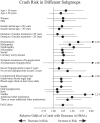Motor vehicle crashes in diabetic patients with tight glycemic control: a population-based case control analysis
- PMID: 19997624
- PMCID: PMC2780354
- DOI: 10.1371/journal.pmed.1000192
Motor vehicle crashes in diabetic patients with tight glycemic control: a population-based case control analysis
Abstract
Background: Complications from diabetes mellitus can compromise a driver's ability to safely operate a motor vehicle, yet little is known about whether euglycemia predicts normal driving risks among adults with diabetes. We studied the association between glycosylated hemoglobin (HbA1c) and the risk of a motor vehicle crash using a population-based case control analysis.
Methods and findings: We identified consecutive drivers reported to vehicle licensing authorities between January 1, 2005 to January 1, 2007 who had a diagnosis of diabetes mellitus and a HbA1c documented. The risk of a crash was calculated taking into account potential confounders including blood glucose monitoring, complications, and treatments. A total of 57 patients were involved in a crash and 738 were not involved in a crash. The mean HbA1c was lower for those in a crash than controls (7.4% versus 7.9%, unpaired t-test, p = 0.019), equal to a 26% increase in the relative risk of a crash for each 1% reduction in HbA1c (odds ratio = 1.26, 95% confidence interval 1.03-1.54). The trend was evident across the range of HbA1c values and persisted after adjustment for measured confounders (odds ratio = 1.25, 95% confidence interval 1.02-1.55). The two other significant risk factors for a crash were a history of severe hypoglycemia requiring outside assistance (odds ratio = 4.07, 95% confidence interval 2.35-7.04) and later age at diabetes diagnosis (odds ratio per decade = 1.29, 95% confidence interval 1.07-1.57).
Conclusions: In this selected population, tighter glycemic control, as measured by the HbA1c, is associated with an increased risk of a motor vehicle crash.
Conflict of interest statement
The authors have declared that no competing interests exist.
Figures


References
-
- Fatality analysis reporting system encyclopedia. Washington (D.C.): National Highway Traffic Safety Administration; Available: http://www-fars.nhtsa.dot.gov/Main/index.aspx. Accessed 15 October 2009.
-
- Centers for Disease Control and Prevention. National diabetes fact sheet: general information and national estimates on diabetes in the United States, 2005. Atlanta: U.S. Department of Health and Human Services, Centers for Disease Control and Prevention. 2005. Available: http://www.diabetes.org/uedocuments/NationalDiabetesFactSheetRev.pdf. Accessed 15 October 2009.
-
- Wikipedia, the Free Encyclopedia. Astronomical unit. Available: http://en.wikipedia.org/wiki/Astronomical_unit. Accessed 15 October 2009.
-
- Evans L. Traffic safety. Bloomfield Hills (Michigan): Science Serving Society; 2004. 444
-
- Steg L, Vlek C, Slotegraaf G. Instrumental-reasoned and symbolic-affective motives for using a motor car. Transportation Research Part F: Psychology and Behaviour. 2001;4:151–169.
Publication types
MeSH terms
Substances
LinkOut - more resources
Full Text Sources
Medical

